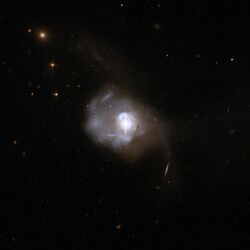Astronomy:Markarian 231
| Markarian 231 | |
|---|---|
 Hubble Space Telescope image of Markarian 231 | |
| Observation data (J2000 epoch) | |
| Constellation | Ursa Major |
| Right ascension | 12h 56m 14.23410s[1] |
| Declination | +56° 52′ 25.2386″[1] |
| Redshift | 0.04147[2] |
| Helio radial velocity | 12173 km/s[2] |
| Distance | 581 Mly |
| Apparent magnitude (V) | 13.84[3] |
| Characteristics | |
| Type | Sc/quasar |
| Other designations | |
| UGC 8058, Mrk 231, Mkn 231, Markarian 231, MCG+10-19-004, ZW VII 490, PGC 44117 | |
Markarian 231 (UGC 8058) is a Type-1 Seyfert galaxy that was discovered in 1969 as part of a search of galaxies with strong ultraviolet radiation. It contains the nearest known quasar. Markarian 231 is located about 581 million light years away from Earth, in the constellation of Ursa Major.
Characteristics
The Markarian 231 galaxy is undergoing an energetic starburst. A nuclear ring of active star formation has been found in the center with a rate of formation greater than 100 solar masses per year. It is one of the most ultraluminous infrared galaxies with power derived from an accreting black hole in the center and the closest known quasar.
A study in 2015 suggested that the central black hole, estimated to be 150 million times the mass of the Sun, may have a black hole companion weighing in at 4 million solar masses, and that the duo completed an orbit around each other every 1.2 years.[4] However, that model has subsequently been shown to be unfeasible.[5]
Another study has found evidence for the presence of molecular oxygen (O2) by using submillimetre astronomy, the first time molecular oxygen had been detected outside of the Milky Way galaxy.[6]
See also
References
- ↑ 1.0 1.1 Brown, A. G. A. (August 2018). "Gaia Data Release 2: Summary of the contents and survey properties". Astronomy & Astrophysics 616: A1. doi:10.1051/0004-6361/201833051. Bibcode: 2018A&A...616A...1G. Gaia DR2 record for this source at VizieR.
- ↑ 2.0 2.1 "Markarian 231". SIMBAD. Centre de données astronomiques de Strasbourg. http://simbad.u-strasbg.fr/simbad/sim-basic?Ident=Markarian+231.
- ↑ Véron-Cetty, M.-P.; Véron, P. (2010). "A catalogue of quasars and active nuclei". Astronomy and Astrophysics 518: A10. doi:10.1051/0004-6361/201014188. Bibcode: 2010A&A...518A..10V.
- ↑ "HubbleSite - NewsCenter - Hubble Finds That the Nearest Quasar Is Powered by a Double Black Hole (08/27/2015) - The Full Story". http://hubblesite.org/newscenter/archive/releases/2015/31/full/. Retrieved 2015-08-27.
- ↑ Leighly, Karen M.; Terndrup, Donald M.; Gallagher, Sarah C.; Lucy, Adrian B. (2016). "The Binary Black Hole Model for Mrk 231 Bites the Dust". The Astrophysical Journal 829 (1): 4. doi:10.3847/0004-637X/829/1/4. Bibcode: 2016ApJ...829....4L.
- ↑ Wang, Junzhi; Li, Di; Goldsmith, Paul F.; Zhang, Zhi-Yu; Gao, Yu; Shi, Yong; Li, Shanghuo; Fang, Min et al. (30 January 2020). "Molecular Oxygen in the Nearest QSO Mrk 231". The Astrophysical Journal 889 (2): 129. doi:10.3847/1538-4357/ab612d. Bibcode: 2020ApJ...889..129W.
External links
- Markarian 231 at ESA
- SpaceRef Feb 23, 2011 Quasar's Belch Solves Longstanding Mystery, from Gemini North Observatory, ApJ March 2011, to be published.
- Chang-Shuo Yan, Youjun Lu, Xinyu Dai, and Qingjuan Yu. "A probable milli-parsec supermassive binary black hole in the nearest quasar MRK 231" 2015 August 14 The Astrophysical Journal, Vol. 809, Iss. 2 doi:10.1088/0004-637X/809/2/117
- http://www.cnn.com/2015/08/31/us/double-black-hole-nasa-hubble-feat/
- http://www.sci-news.com/astronomy/science-supermassive-binary-black-hole-markarian231-03180.html
- http://dso-browser.com/dso/info/UGC/8058
 |

